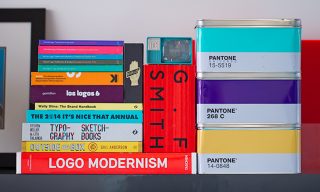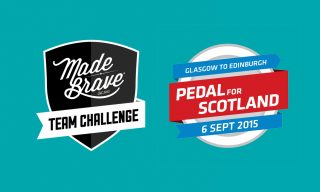We kick it old-school with Ciaran Glöbel; typography geek, hand-painted sign artist and the creative genius behind Glöbel Bros Signs & Designs.
Smack bang in Glasgow’s city centre, you’ll find what is essentially Willy Wonka’s chocolate factory for typography fans – the HQ of Glöbel Bros Signs & Designs. For those who haven’t met Ciaran, he’s a hand-painted sign artist, which means his work is a no-vinyl zone, just a smorgasbord of wood, enamel paint and a big glug of design talent. Pretty cool huh? We popped along to talk graffiti, art and digital (and to see the man himself in action).
When did you first become interested in sign painting?
I’ve been a commercial artist for about six or seven years, but was using spray paint, stencils, loads of masking tape and emulsion with big brushes and just slapping colour on, so I never actually started using enamel paint until about two years ago. It’s a whole different skill set, using emulsion and acrylic is something that I’ve always done, but this paint is so hard to use and these brushes and crazy sometimes. It takes a long time to get your head around them. So probably in its current state, I’ve been doing this for just under two years. You could say that I’m very much a novice, because it seems like you need to put in a good five, ten years before you can really be a part of the brush (I know that sounds really airy-fairy, but you know what I mean) and really understand how it works. I’m only just grasping now how to make letter forms tidy and clean and there’s still a lot to learn. You rest on your laurels a bit when you know how to blend two colours, but you want to put a sheen in it and play with light more, so you can cast shadows and convey light.

What’s your background?
I come from a graphic design background and did it in college for a few years when I left school, a long time ago. So you’re talking maybe 2004 or something (maybe even longer than that) but then I never really followed it, just did my own thing, worked for myself making gig posters for my pals and making no money really, working in bars etc. But doing graphic design really helped me, I probably would’ve struggled more with typography without it. But a lot of my work comes from graffiti, I did it a lot when I was younger. None of the letter forms are the same, but the drop shadows and blends of the colours are all really similar. So what I do in sign painting comes from graphic design and graffiti equally.
Would you say there’s a crossover with the street art scene, and graffiti and sign painting?
Yep, absolutely. Graffiti culture, tattoo culture, we probably share a kinship with hot rod Pinstripers too.

What’s your process?
It’s important to be able to visualise things, so I do things in Photoshop or Illustrator first to figure out how it’s going to work and what colours work best. It’s necessary if someone wants to see your work first before you paint it. So I guess that’s where digital and sign painting meet. During the Merchant City Festival, I had the pleasure of meeting a guy called Mike Meyer, he’s from a wee town in Minnesota and has been a journeyman sign painter for years. He was telling us the stories from back in the day when he first started and how it is now, he said he remembers when he was younger, having to drive to another town to meet the customer, then see what they wanted, then go home to draw it out, then either post it to them or drive to the next town and show it to them again, then drive back, so by the time he had actually wet his brush, he had spent hours of not doing any work and not getting paid for it, so when it comes to digital he was like“just fucking go for it, whatever makes your job easier”. Nothing’s ever easy, but if there’s something makes it a wee bit easier it’s better.
You mention digital – how does it compare to sign painting?
I think people are quite nostalgic. DIY culture really drives this, you could say it’s a bit of a joke, with hipster culture too haha! But also it’s practical, it’s way more practical than it is a style fad. People dig it because it’s old-worldy, but also the customer digs it because it’s probably on par with price for vinyl nowadays, vinyl’s what put sign painting out of business – everyone got a computer and just churned out these vinyl stickers, but somewhere between then and now, the cost has gone up. People want quality now and sign painting delivers that.

Where do you look for inspiration?
I use Instagram alot, sometimes if I’m having a total mental block, I’ll go on social and look at other sign painters’ work for inspiration. Educationally, there’s a few books that every sign painter should own: A book by Bill Stewart called ‘Signwork’ and ‘The Art of Eye Appeal’ by Mike Stevens. There’s nothing particularly Instagrammy about what’s in these, but if you’re stuck and need to know how to do something, these are like bibles to refer back to. These would typically be given to an apprentice without a graphic design background who needs to know the difference between Old English and Fraktur and what Blackletter means and what Roman means.
Are there any particular ‘base fonts’ that sign painters should know?
In terms of the fonts themselves, you could say that they’re all completely custom because when the sign painter paints them, they might be based on something particular, but they’re never all the same. But yes, there are different font styles that you use, so you’ve got Egyptian which is sans serif with consistent letter width, and you’ve got Roman lettering which is thick and thin (like bridges in letter H’s) and you’ve got Casual letter, which is just what the name suggests – every designer has their own free hand casual lettering style. You can often tell the painter from their casual, especially in the way they cross their ‘A’ and the way their style their ‘S’.

What other differences are there in style?
A lot of the time it can be based on location, so London style is different from Brooklyn style: London style is actually a term we use, it’s just a style of calligraphy, that’s usually gold leaf on high gloss black, very much like an old London pub style. Where if you look at Limerick or Dublin style painters, their style is quite different. There’s a difference in texture – so if the word ‘sign painters’ was written in the style of Dublin and a Brooklyn style, you could probably tell which one was which by the choices of font and the style. There’s also something called the Boston Gild – they use two types of gold leaf in a lower or higher carat for the outline and fill. It’s used all over the world but it was typical to Boston at the time. Maybe in the future there will be a Glasgow style.
Are there any other sign painters who inspire you?
When I first started and just didn’t get it, I contacted maybe three or four sign painters, three didn’t get back to me, but James from Saloon Signs did; he’s a really great guy, he’s like a genius, every time I meet him he has some new way of storing his paint or some new way of getting a drawing onto the surface and not using just chalk, he’s a really smart guy. Of course, Mike Meyer as I said, Frank Carty from Artisan Artworks who I’ve worked with before and Harry Swan, he works from a wee shed in his back garden. I also really like Pierre Tardif, I love his style, it’s very 1950s America, really optimistic and bold. He’s really good at doing showcards.

Showcards?
They’re what you’d get in supermarkets about fifty years ago, they’d say something like ‘a pound of bananas is so many dollars and cents’. Pierre Tardif does these to a fine art. Turns out, sign painters don’t charge a lot for these, but once the supermarket offer’s over, they’ll take the sign away, then put it on Ebay as art and they’ll sell for a hundred quid! It’s funny because it’s utilitarian in that it’s used to say how much tomatoes are, but then when you take it out of a supermarket context and put it in a frame it’s fine art and people pay hundreds of dollars for it, so it’s a whacky world, but that’s a funny bit of insider knowledge that I found out from another sign painter.
Ahh great tip! What would you say are the things you love most about being a sign painter?
You kinda need to have a bit of an ego, I’m not afraid to admit that and that comes from graffiti, because that’s the whole reason you do graffiti, it’s a friendly competition with your peers and so the same goes for sign painting – who can push the envelope more, who can work better and quicker? When you do a good painting, you take pride in it. Maybe ego’s a bit of a dirty word, you get a sense of pride. Other than that, it’s good to be your own boss. It takes a certain type of individual to thrive in this industry. I like a good day’s work, I like working with my hands and being outside and not have to sit at a desk all the time.

What advice would you give to people starting out?
I’d say, get a starter kit, just a few different colours of paint and brushes and go on YouTube, that’s how I learned! Then work hard at it and don’t be disheartened because the learning curve is very steep. You might go six months fighting the tide, the one day it will just stick.
What’s the bravest thing you’ve ever done?
I’m not the best with heights, so working 40ft off the ground is quite brave. Another would be printing off my business cards and being like ‘this is my business now’. For any sign painter, taking on digital is brave, so many people are immersed in it now and we’re out here taking it back to a time before digital in a completely different direction.
Check out Glöbel Bros Signs & Designs online and Instagram.
Hey you! Yes, you. Fancy featuring on MadeBrave Meets? Drop us a line at hello@madebrave.com



